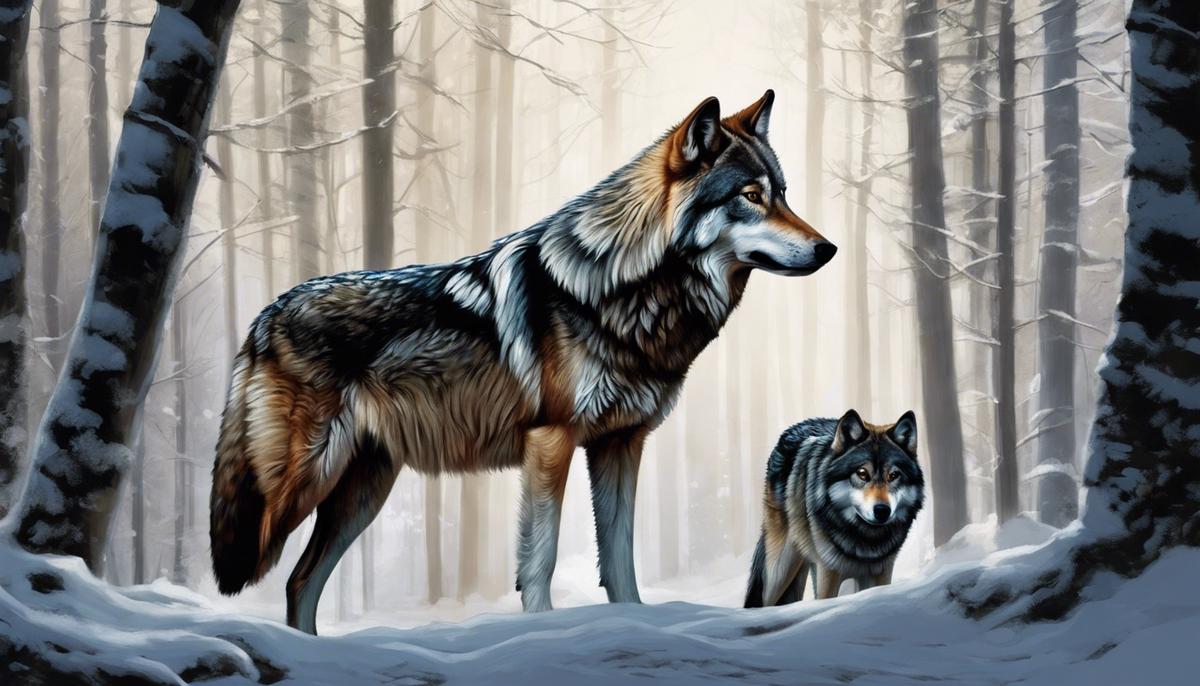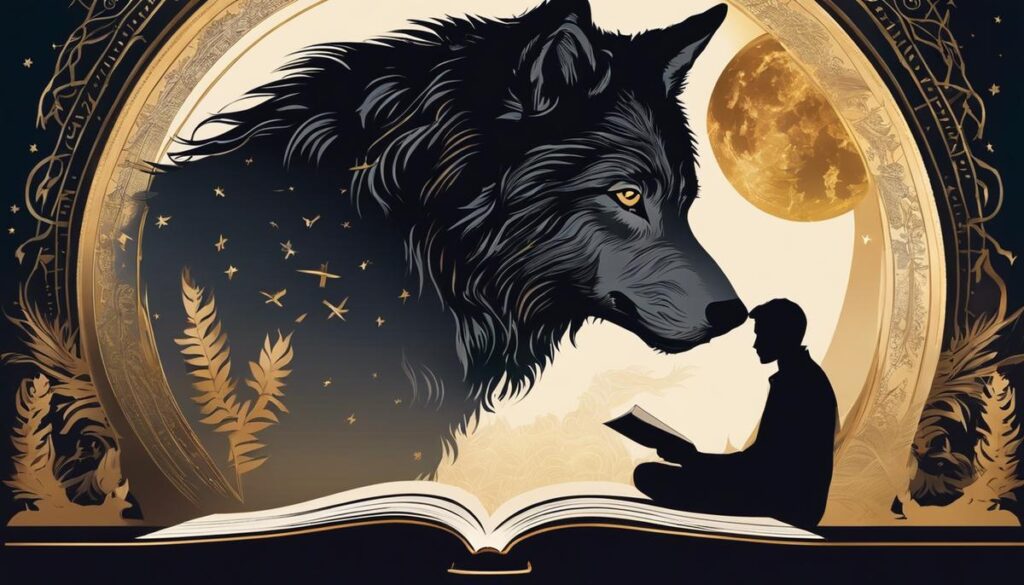In the vast realm of dreams, symbols weave intricate stories that mirror our deepest fears, aspirations, or subconscious notions. Among these symbols, the image of a wolf commands attention, invoking a sense of awe, sometimes fear, and often mystery. This essay delves into the obscure world of dream symbolism with a singular focus on the representation of wolves, a cornerstone figure in a plethora of cultural narratives and biblical anecdotes. Tracing the origins of dream interpretations back to the ancient Egyptians and Greeks, it reaches into the heart of biblical representations for an exploration that bridges the divide between societal views and the unique, personal interpretation that psychoanalysis provides.
History and Interpretation of Dream Symbols
Dreams, those captivating nightly journeys into the unconscious mind, have held a place of analytical and cultural significance for millennia. Understood largely through subjective interpretation, they act as fascinating gateways into the human psyche and our societies at large. Perhaps the most engaging aspect of dreams lies within their symbols – elements that occur within the dream narrative carrying an iota of message to be deciphered. To glimpse the comprehensive influence and historical relevance of interpreted dream symbols is to embark on a spanning journey touching on culture, religion, psychology, and even neuroscience.
Since time immemorial, the interpretation of dream symbols has roosted at the intersections of divination, prophecy, emotional exploration, and societal norms. Ancient civilizations, such as the Sumerians in Mesopotamia, recorded their dreams on clay tablets, drawing interpretive connections between dream symbols and real-world outcomes. The Egyptians developed a formal system of dream analysis, putting great emphasis on vivid symbols like serpents or large bodies of water, and placing them within a context of cultural relevance and religious significance.
In addition to functioning as perceived divine channels, dreams and their symbols often operate as mirrors reflecting cultural ethos. Unsurprisingly, the nature of these symbols varies fiercely from one society to another, underscored by societal norms, values, fears, and aspirations. For Victorian England, an era steeped in propriety and repression, dreams provided a conduit for the exploration of the unspoken, unexpressed thoughts and desires. In certain African cultures, dreams serve as integral connectors to ancestral wisdom, the symbols acting as messengers conveying important insights.
The interpretation of dream symbols became more systematized with the arrival of psychoanalysis in the 20th century. Driven by eminent figures like Sigmund Freud and Carl Jung, dream interpretation transitioned from the metaphysical realm into the scientific. Freud posited that dream symbols served as disguises for suppressed desires, while Jung suggested these symbols as universal archetypes ingrained within a collective unconscious. Their theories not only invigorated the study of dream analysis but offered a rich extension of understanding human behavior.
Understanding dream symbols not only opens a door to human psychology but also extends its reach into neuroscience. Recent advancements suggest that dreams could potentially act as a neural cleanser, aiding the brain in processing emotions and experiences. Thus, deciphering dream symbols could inch closer to making sense of the vast neural labyrinth that makes us who we are.
In conclusion, the historical and cultural significance of interpreting dream symbols is profound, touching on faith, societal norms, psychology, and even brain health. While the frontiers of dream analysis continue to expand, its significance undulates well beyond a nocturnal occurrence. Just as it did for the ancients, the interplay between the dream state and waking life continues to fascinate, engage, and confound, and the symbols within our dreams persist, shimmering on the fringes of our sleep-woven narratives with mysteries yet to unravel. The depth of knowledge, insights, and nuances that dreams reveal about our collective and individual psyches have confirmed, and will continue to affirm, the importance of dreams and their symbols in human exploration and understanding.

Biblical Representations of Wolves
Wolves in Biblical Narratives: Subtext and Significance
With a primordial lineage closely intertwined with human fate, the wolf, a creature that encapsulates the raw, untamed wild, has long held a mercurial but significant presence in cultural representations, religious texts, and particularly, biblical narratives. Acting as multifaceted symbols with nuanced meanings, wolves in the Bible independently weave a backdrop of spiritual and moral lessons.
To glimpse the complexities of biblical wolves, consider the Books of Genesis and Isaiah, where wolves are imbued with strong representational significance. In Genesis, the tribe of Benjamin is symbolized as a wolf, signifying courage, unity, and resilience, which encapsulates the inherent wolf-like traits of cooperation and survival instinct. Wolves here are not the stereotypical villains but an embodiment of collective strength and willingness to survive against great odds.
Conversely, the Book of Isaiah presents a future vision where wolves coexist peacefully with lambs, personifying harmony, reconciliation, and the future Kingdom of God. This change showcases the transformative value of wolves, emphasizing their essential neutrality where context and relation define their roles, not inherent characteristics.
On a more somber note, wolves weave into narratives as cautionary symbols. In the Books of Jeremiah and Ezekiel, the wolf is a portent of destruction and desolation. Wolves here epitomize the destructive potential of unchecked power and misuse of authority, urging the reader to ponder upon the consequences of ethical disregard.
Among the teachings of Jesus, the analogy of the “wolves in sheep’s clothing” emerges, elucidating the theme of deception. This proverbial use of the wolf warns against false prophets – individuals who, like wolves, may appear benign but harbor harmful intentions. Hence, wolves in this context become harbingers of duplicity, underscoring the importance of discernment.
From an academic perspective, this diverse representation of wolves in the Bible is a testament to the dynamic relationship between society and its surrounding fauna, reflecting the multifarious facets of human morality. Furthermore, it underscores the interpretative richness of biblical symbols, contributing to the complexities of human understanding.
In conclusion, the thread of the wolf running through the biblical tapestry is undeniable. Despite their reputation in certain circles as creatures of malevolence, their biblical depiction bends and flexes under the lens of symbolic interpretation. As an animal emblem embodying various human ideologies and moral tenets, the wolf stands as a testament to the interpretive richness and philosophical depth of biblical narratives.

Psychoanalytical Interpretations of Dream Wolves
Having addressed the historical, cultural, and psychoanalytical significance of dream symbols, this article delves into the specific usage of wolves as symbols within dreams. The focus is primarily on psychoanalytical theories which further elucidate the representation and perception of the wolf in the realm of dreams.
In the realm of psychoanalysis, the wolf’s presence in dreams is often linked to raw emotions and primal instincts. Sigmund Freud, the father of psychoanalysis, viewed animals in dreams as embodiments of suppressed desires and instincts. He suggested that the wolf, typically represented as wild and untamed, may symbolize a person’s repressed fears or anxieties, while at times it may also signify the dreamer’s restrained aggression or anger.
Carl Gustav Jung, another eminent psychoanalyst, proposed a different outlook. To him, the wolf embodies the ‘shadow’ archetype – a representation of the unconscious mind consisting of repressed weaknesses, shortcomings, and instincts. The ‘shadow’, being an integral part of the psyche, integrates the unconsciousness and consciousness. Therefore, a wolf in your dream might suggest a need to accept and understand the darker aspects of yourself.
Wolves are social animals that live and hunt in packs, symbolizing community, loyalty, and familial ties. Thus, according to psychoanalytic theories, a dream of a peaceful wolf or wolf pack may also suggest a longing for a sense of belonging or a need for family and community bonding.
In a few instances, the gender of a wolf in a dream plays a significant role in psychoanalysis. The female wolf, or she-wolf, is often linked with maternal instincts, representing nurturing and protective feelings. A dreaming of a she-wolf may indicate a desire for protection or the dreamer’s protective instincts towards someone.
Moreover, wolves are apex predators and dreaming of a ferocious wolf might also symbolize a threatening situation or a feeling of vulnerability in waking life. Psychoanalysts believe that deciphering such dreams requires thorough understanding of one’s psychological state and current life situations.
It’s crucial to consider these interpretations are not universal, but can heavily rely on the dreamer’s personal experiences, associations, and feelings towards wolves. For some, a wolf may embody fear and threat, for others, it may stand for freedom or companionship.
Thus, the apparition of wolves in dreams can offer valuable insights into one’s subconscious mind, providing a pathway to understanding suppressed emotions, personal characteristics, and situational vulnerability. Psychoanalysts emphasize on person-centered interpretation, as dreams are highly subjective experiences woven into the intricate tapestries of individual lives.
In interpreting the appearance of wolves in dreams, one can decipher nuanced messages from the subconscious, enhancing self-awareness and promoting personal development. This area of psychoanalysis continues to offer a rich landscape for exploration, each new study contributing to an engulfing ocean of understanding about the human psyche.
Therefore, in unveiling the mysteries of our nocturnal narratives and decoding the symbols ensconced within them, like the elusive wolf, we navigate not only the dream world but also the hidden depths of our unconscious mind. One could rightfully opine that our dreams, in all their rich symbolism and vivid narrative, offer an intimate connection to the very core of our being, a connection that continuously enthralls the scientific and academic community.

Biblical Interpretations of Wolves in Dreams
The conjugation of biblical interpretations and contemporary psychological theories in the understanding of dream symbols manifests an intriguing study area, particularly regarding specific symbols such as wolves. In the Bible, the wolf carries both positive and negative connotations, representing danger or unity, destruction or reconciliation.
In the Old Testament, the wolf appears as a dichotomous symbol. It is associated with courage and unity in the context of the tribe of Benjamin, depicted as a “ravening wolf” that “devours the prey, and at evening divides the spoil’ (Genesis 49:27). Here, the wolf symbolizes the notable bravery of the tribe in battle, united by a common purpose. It conveys the strong communal ties that are often associated with pack animals like wolves.
The prophet Isaiah, envisioning the Kingdom of God, portrays wolves as peaceful creatures, saying, ‘The wolf will live with the lamb…’ (Isaiah 11:6). The wolf here becomes a symbol of reconciliation and harmony, showcasing the transformation of natural animosity into peaceful coexistence, aligning with future divine order.
However, in the Books of Jeremiah and Ezekiel, the wolf incarnation takes a cautionary turn, indicating destruction and desolation, a sharp deviation from its portrayal in other contexts. Identified as agents of ruin, they are depicted as ‘wolves of the evening,’ that run rampant in fortified places, laying waste to the land (Jeremiah 5:6, Ezekiel 22:27).
A popular biblical expression, ‘wolves in sheep’s clothing,’ originates from Jesus’ teachings, cautioning devout followers to be vigilant about religious impostors, thereby imbuing the wolf symbol with implications of deceit. Hence, discerning genuine wolf sightings in dreams from those masquerading as sheep earns significance.
From a scientific frame, Freud’s psychoanalysis conceives animals in dreams as representing instinctual urges. The wolf may typify repressed fears or aggression in light of Freud’s work. At the same time, Jung provides contrasting interpretations, identifying the wolf as echoing the ‘shadow’ archetype in his diagrams of the psyche, signifying the primal, uncivilized part of one’s personality.
Symbolically, wolves also signify a sense of community, loyalty, and familial ties, often associated with their pack behavior. Further, the gender of the wolf appearing in dreams could lend additional insight into the dreamer’s mental state. If it’s a male, it could imply aggressive, assertive aspects while a female might denote nurturing characteristics or issues related to motherhood.
A dream involving a ferocious wolf may symbolize a threatening situation or vulnerability, revealing the dreamer’s deep-seated anxieties. On the other hand, a tame wolf could denote acceptance of the self, embodying Jung’s notions of integrating the ‘shadow’.
Modern theories stress the subjectivity of dream interpretations, underlining the importance of personal experiences and associations. While these interpretations provide general frameworks, the actual meaning may vary significantly for each individual. The individual’s personal or cultural experiences with wolves can greatly influence their interpretation of such a dream.
Thus, the intertwining of biblical and modern psychological interpretations provides a wide lens to evaluate and harness the symbolism of the wolf. Whether viewed as a prophet’s warning, a patriarch’s blessing, a symbol of shadow aspects, aggressive instincts, or community bonds, the wolf in dreams continues to remain a fascinating symbol, inviting continuous exploration and study.

A journey through history, cultural narratives, the labyrinth of the human psyche, and biblical wisdom underscores the significance of wolf symbolism in dreams. Throughout history and biblical narratives, the wolf has been a potent metaphor that captures human interaction with the complex universe of dreams. As we strive to navigate this space with the guidance of ancient wisdom and psychoanalytical insights, it becomes evident that each encounter with the wolf in our dreams invites us to come face to face with our fears. Thus, unearthing, understanding, and interpreting wolf symbolism can aid in self-awareness, guiding us to confront the elusive mysteries within our subconscious.








